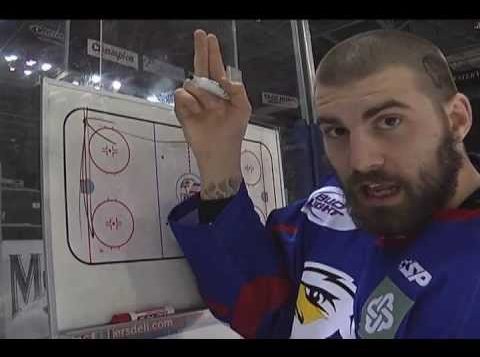This Day in Hockey History – September 24, 1937 – Ice Icing Baby
Photo: YouTube
It seemed that many of the most memorable meetings of the NHL Board of Governors had the Boston Bruins to thank for noteworthy events. At the meeting held in New York on September 24, 1937, Art Ross suggested a new addition to the rulebook that became the icing rule.
Icing was to be called when a player shot the puck from his defensive zone past the opposite goal line. Today, as Rule 81 in the NHL Official Rules, “should any player of a team, equal or superior in numerical strength (power-play) to the opposing team, shoot, bat or deflect the puck from his own half of the ice [over the center red line] beyond the goal line of the opposing team, play shall be stopped.” Thus, icing does not count when the defenders are short-handed.
In 1937, the Boston Globe reported: “Under the new rule a whistle will stop play on such occasions and the puck will be faced at the point from which it was shot up the ice. The rule will not apply, of course, when the defensive team is short-handed and under no circumstances will the puck be faced nearer than 15 feet from the goal.” The day following the rule change, the term “icing” had not been announced, but by September 28, the Baltimore Sun described it thus: “If two teams are of the same strength and one team undertakes to ‘ice’ the puck, the referee will call a face-off at the point from which the disk was ‘iced.’ The term ‘icing’ is applied to the practice of shooting the puck the length of the rink to waste time.”
That Boston raised the issue was no surprise. They had held a grudge against “kitty-bar-the-door hockey, or at least that defensive gesture whereby a hard-pressed team relieves the pressure by icing the puck the length of the rink” since at least December 8, 1931. That night, they lost their first home game of the season 3-2 in part because the New York Americans kept shooting the puck from end-to-end to stall and take breaks while maintaining their lead. As the Boston Globe reported, “In that feverish third period, when the New Yorkers were sorely pressed, McVeigh, Himes and Dutton did some very fancy stalling. … And of all the players who shoot the puck the length of the rink to relieve pressure, nobody does it more scientifically than Dutton.” The Americans even took advantage of the crowd’s protest against their style and the referee calls. They insisted the ice be cleared of the thrown papers, which caused bottles to be thrown. The game was delayed ten minutes for their removal.
When the two teams met for a rematch in New York on January 3, the Bruins retaliated. Apparently, their owner, Charles F. Adams threatened them with fines if they did not play defensively. Thus, the Globe summarized that the Bruins “somewhat peeved at what they termed the drab defensive play of the Amerks … set out to give the New Yorkers a taste of their own medicine and in the first period they ‘golfed’ the puck down the ice no less than 40 times while making no pretense of a serious attack.” Calling this “probably the poorest excuse for a National Hockey League game ever seen anywhere,” the New York Daily News counted that by the end, the Bruins had “shot the disk without excuse the length of the rink – or, at least, from outside the blue line – no fewer than 89 times.” By their count, the Bruins had “golfed” the puck 42 times in the first period, 14 in the second, 16 in the third, and even 17 times in overtime. The only result was that the teams had the first scoreless draw of the 1931-32 season.
According to some sources, New York Rangers President John S. Hammond said the Bruins should be fined, but NHL President Frank Calder noted that nothing in the rulebook prevented this tactic. It took almost six years to change that.
At the same 1937 meeting, several other rule changes were announced by the NHL Board of Governors. They included:
- In cases when a puck is shot over the boards, a faceoff will be held at the point where the player shot not where the puck went out of bounds.
- Goalies would no longer be penalized for freezing the puck against the boards.
- If a player other than the goalie deliberately falls on the puck within 10 feet of his goal, the opposing team will receive a penalty shot but the offender will not receive a two-minute penalty.
- Any player who has accidentally dropped or broken his stick can kick the puck without penalty.
- Fouls committed when play has ceased would draw the same penalties as when play was in progress.
- All rinks were to be equipped with electrical timing devices (like those used in Toronto and New York).
Additional Sources:
- Mike Commito, Hockey 365: Daily Stories from the Ice (Toronto: Dundurn, 2018), kindle edition.
- https://nhl.bamcontent.com/images/assets/binary/308893668/binary-file/file.pdf
- Victor O. Jones, “Bruins Obtain Art Jackson, But Bid for Bowman Fails,” Boston Globe, 25 Sept. 1937, p. 6.
- “Clancy Rejoins Gorman With Maroon Sextet,” Brooklyn Daily Eagle, 25 Sept. 1937, p. 15.
- “Signing of Clancy to Coach Maroons Features Meeting,” Montreal Gazette, 25 Sept. 1937, p. 16.
- Jesse A. Linthicum, “Sunlight on Sports,” Baltimore Sun, 28 Sept. 1937, p. 15.
- Victor O. Jones, “American Defeat Bruins By 3 to 2” and “Cracked Ice,” Boston Globe, 9 Dec. 1931, pp. 24 and 30.
- “Boston Too Busy Making Length-of-Rink Shots to Score in Overtime Tie With Amerks in NY,” Boston Globe, 4 Jan. 1932, p. 7.
- Pat Robinson, “Bruins Save Their Dough,” New York Daily News, 4 Jan. 1932, pp. 34-35.














